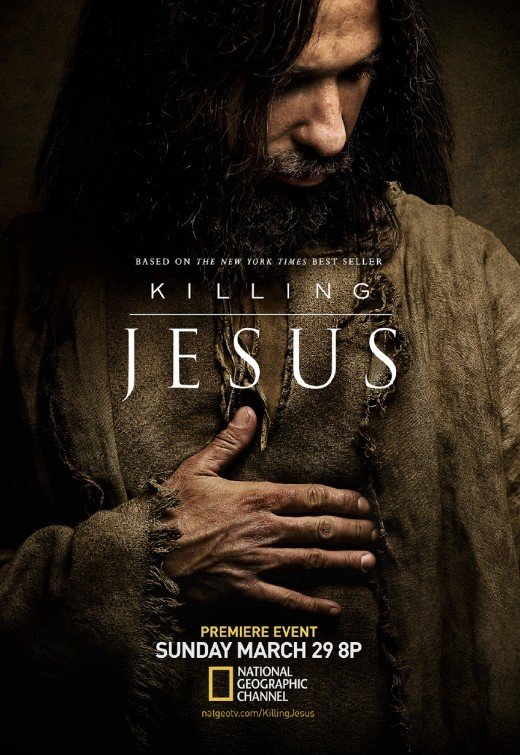“Lost in Translation”
What You Need To Know:
Like the book, KILLING JESUS shows Jesus Christ’s tomb was found empty but it doesn’t describe the resurrection appearances of Jesus. Unlike the book, the movie’s Jesus performs no miracles and only starts proclaiming Himself the Son of God after Peter tells Jesus that’s who Jesus is. Also, Jesus is full of doubt at the beginning, unlike the book. The KILLING JESUS movie is well shot and acted, but not as compelling as the book, and certainly not as compelling as the New Testament Gospels.
Content:
(Pa, RHRH, FR, CC, BB, VV, S, N, A, M) Light pagan worldview with strong revisionist history of the New Testament Gospels about Jesus Christ, leaving out the miracles of Jesus and focusing on his crucifixion and the empty tomb and his message of love and forgiveness, but leaving out any reference to reports of his resurrection appearances and minimizing the teaching that Jesus claimed to be the Son of the living God, unlike the book on which the movie is based; no foul language; strong violence when Herod the Great sends soldiers to murder newborn boys, when Jesus is whipped, when a crown of thorns is placed on His head, when Jesus is hit, when Jesus is crucified, when an image of John the Baptist’s decapitated head is shown; incestuous implications Herod Antipas licks his daughter’s knee while she dances suggestively so she can get her father to kill John the Baptist, who slams Antipas for marrying his brother’s wife; upper male nudity from time to time; light alcohol use; no smoking or drugs; and, betrayal, persecution, illegal trial, oppression but rebuked.
More Detail:
O’Reilly and Dugard’s book KILLING JESUS has been criticized in some Christian circles because it doesn’t confirm such things as the historicity of Christ’s resurrection or the two thieves that were crucified next to Jesus. It’s also been alleged that the book doesn’t confirm the miracles of Jesus or Jesus Christ’s claims to be divine.
The first two points about this book are actually true, but, in their defense, O’Reilly and Dugard write that their book is not a religious or theological book, but a book that looks at the historical background to Jesus Christ and that examines his life, his teachings and his murder. Thus, they say they couldn’t confirm the New Testament’s references to the two thieves, but they do say in their book that the apostles who followed Jesus, and the other early disciples who knew Jesus personally, did believe that Jesus rose from the dead. They also confirm the fact that, after Jesus died, Mary Magdalene and another woman named Mary (not Jesus’s mother) went to his tomb and found it empty. On Page 259, they add, “To this day, the body of Jesus of Nazareth has never been found.”
The second two allegations about KILLING JESUS, however, don’t seem to be true.
First, the book does indeed read as if O’Reilly and Dugard accept the biblical reports that Jesus did indeed heal the sick, make the lame walk, raise the dead, cast out demons, etc. In fact, in referring to these “signs,” “wonders” and “miracles,” the book says that “a staggering number of witnesses are attesting” to “every one” of these signs, wonders and miracles (Page 156). It adds, “The Pharisees believe in miracles but not in Jesus” (Page 156). Later on, Page 176 of the book describes the reports of the physical resurrection of Jesus’s friend, Lazarus, as if this miracle actually occurred. Furthermore, a note on Page 199 says that the reports of this particular miracle were “a main component in the Temple priests’ plotting against Jesus.”
The book KILLING JESUS also says multiple times that Jesus claimed to be the Son of God and the Messiah. It also compares such claims to a claim of divinity. Finally, it says specifically in a note on Page 76 that Jesus did indeed claim to be divine.
MOVIEGUIDE® did find one huge factual contradiction in the book, however. In a note on Page 22, it says the Gospel of Matthew in the New Testament was written “sometime between A.D. 50 and 70.” However, on Page 103, O’Reilly and Dugard say Matthew was written in the 70s. This is a major contradiction that should be fixed. MOVIEGUIDE® agrees with the note on Page 22. The best historical scholars believe Matthew was indeed written between A.D. 50 and 70, probably before A.D. 60 or 65.
Another problem with the book is the lack of historical documentation. There are no footnotes, and the book sometimes reads like a summary of the New Testament Gospels, but without the brilliant historical context and gripping theological content that makes the Gospels, and Jesus Christ, stand out more than all the other books and people in history that the human race has venerated or worshipped. That said, O’Reilly and Dugard’s book is a fast, captivating read and, although it doesn’t describe the resurrection appearances, has helped some people with their Christian faith and convinced others to consider becoming a Christian. That said, readers will find books like Lee Strobel’s THE CASE FOR CHRIST even more compelling and convincing. Of course, no other book can replace an open-minded reading of the four Gospels themselves, which are THE eyewitness testimony of what Jesus really said and did.
On March 29, the National Geographic Channel on Cable TV will air a two-hour movie version of KILLING JESUS. Movieguide® has screened the movie.
The two-hour movie version of Bill O’Reilly and Martin Dugard’s bestselling book KILLING JESUS is not a faithful adaptation of the book. The book may be criticized for its weak historical documentation, lack of footnotes referring to specific sources, and noncommittal approach to the resurrection. However, the movie version is even weaker, giving its viewers a Jesus who’s not divine, who’s full of doubt at the beginning, though He gets stronger later. Also, unlike the book, the movie seriously plays down the divinity of Jesus and His teaching that He was the incarnate Son of God.
The movie begins with King Herod the Great having a vision of the Prophet Isaiah that Herod will be replaced by a mightier king. Then, Herod hears of the messiah being born in Israel, so he orders his men to murder every male baby in the land. Jesus escapes this awful slaughter, because his adoptive father, Joseph, decides they will be safer in Egypt. Seven years or so later, Herod the Great dies, and Joseph, Mary and Jesus return to Israel.
Twenty years later, the Romans make Pontius Pilate governor of Judea. The zealots attack Pilate’s wife in the streets. The high priest, Caiaphas, tells Pilate that the zealots from Galilee are to blame. So, Pilate orders Herod’s son, Antipas, who’s been made ruler over Galilee, to find the zealots and kill them.
Meanwhile, Jesus hears of his cousin, John the Baptist’s, ministry and goes to see him. At the river, John proclaims Jesus the Lamb of God who takes away the sin of the world, but Jesus is doubtful. Later, John baptizes Jesus, but it’s a private baptism, unlike the public baptism in the New Testament documents and in O’Reilly and Dugard’s book.
Finally, Jesus begins His ministry with Simon Peter and the apostles. Jesus seems to heal a demon-possessed boy. Antipas arrests John the Baptist. Jesus talks all too briefly with Nicodemus (Chapter 3 of John), but speaking only of bringing God’s love and light. The same night, Jesus hears about the Baptist’s arrest and imprisonment and gets angry, wondering whether he shouldn’t bring a sword instead of preaching about love. The next scene shows Jesus preaching in the Temple in Jerusalem against the priests and saying the temple will be destroyed. He also preaches that they will destroy “this” temple, but that he will raise it up in three days.
Cut to his mother Mary and his brother James questioning Jesus about reports of him healing the sick. Jesus replies that he only comforts the sick, but it is God who heals them. He adds that a prophet is not recognized among his own people.
As the wife of Antipas tells him he should execute John the Baptist, Jesus preaches forgiveness to Matthew the tax collector and the crowd around him. Then, he comforts a woman stricken with leprosy but doesn’t heal her. After that, he gives a truncated version of the Sermon on the Mount, ending with the recitation of the Lord’s Prayer, “Our father who art in Heaven,” etc.
[SPOILERS MAY FOLLOW] Caiaphas informs Pilate about Jesus Christ’s ministry and its danger to Rome. He adds that Jesus is the cousin of John the Baptist. “I’m being menaced by a family of lunatics!” Pilate says. He orders Antipas to execute the Baptist, but Antipas refuses. However, his wife connives with her daughter Salome, who seduces her father, Antipas, with her dancing, and Antipas finally orders the Baptist beheaded. Jesus now realizes it will soon be His turn to suffer such a martyr’s death. He prays to the Father to give him the strength to endure this “bitter cup.”
The same evening, Jesus asks His apostles who do people “say that I am.” The apostles debate it, but then Simon says Jesus is “the anointed one, the Son of the Living God.” Jesus replies that it isn’t He who has revealed this to Simon but God. He adds that, from now on, Jesus will call Simon Peter (the Greek word for rock) and, upon this rock, Jesus will build His church while giving Peter “the keys to the Kingdom.” Jesus leaves the apostles, and Judas warns Peter against calling Jesus the Messiah. Peter replies, “What harm can come to God’s chosen?”
After this, Jesus offends the priests by encouraging people to release the woman caught in adultery. Caiaphas goes to Pilate and asks him to move against Jesus, but Pilate tells him that he needs more evidence for Jesus’s sedition than they have given him. Bring evidence of sedition against Roman rule, Pilate tells him, and he will take action.
Before going to Jerusalem for the last time, Jesus is upset when his apostles James and John argue about helping Jesus judge the evil people who oppose them when Jesus finally sits on His throne. Jesus tells them being a servant is better. He also says He came to give His life a ransom for the many, adding “I am the resurrection and the life. And, those who believe in me, even though he were to die, will live.”
Jesus comes to Jerusalem riding humbly on a donkey, to the cheers and hosannas of the crowd. He teaches in the temple, talks about the two greatest commandments in the Bible and the Golden Rule, brilliantly answers a tax question from a spy trying to trip him up, and overturns the money lenders in the temple the next day.
In the movie’s last 40 minutes, Jesus and the apostles meet for Passover, Judas betrays Jesus, Jesus is eventually handed over to Pilate, and Pilate orders him whipped, then orders him crucified. Nicodemus and Joseph of Arimathea place Jesus’s body in the tomb. Caiaphas asks Pilate to station a Roman guard at the tomb, but Pilate seems to refuse. Three days later, the Virgin Mary, Mary of Magdalene, Nicodemus, and Joseph of Arimathea go to the tomb and find that it’s empty, the body of Jesus gone. A final scene shows Peter praying in a boat and receiving a miraculous catch of fish, then raising his eyes skyward while promising Jesus, “I will be your fisher of men!” A brief narration tells the viewer the obscure destinies of Pilate, Antipas and Caiaphas and says that the apostles died for their faith, but, unlike the book KILLING JESUS, there is NO reference to the resurrection appearances of Jesus to Mary of Magdalene, Peter and the other apostles and disciples that were such a huge part of their Christian faith.
KILLING JESUS is shot well, flows smoothly and has excellent performances, but some viewers may find it hard figuring out sometimes who is who from scene to scene. Also, its view of why Jesus was crucified is mostly political. The movie seems to say it was done mostly to maintain order. Unlike the book, only three times does the movie make reference to Jesus Christ’s claim to be the Son of God. Also, there are no miracles in the movie, although the book mentions many times that Jesus was reported to be a miracle worker. In fact, the book contains a startling description of the reports of his resurrection of Lazarus from the dead, but this scene is nowhere to be found in the movie. So, ultimately, the movie’s focus on the political machinations prevents it from displaying the majesty of Jesus’s teaching and the real jeopardy He and His disciples were facing. A merely political explanation for the crucifixion isn’t a complete answer.
Ultimately, however, it’s the movie’s unsatisfying portrayal of the book by Bill O’Reilly and Martin Dugard and its even less satisfying portrayal of the New Testament Gospels and the teaching of Jesus and His apostles that makes KILLING JESUS a failure. Although the movie contains snatches of truth, it ultimately distorts that truth, reducing Jesus Christ’s message to one of just repentance, forgiveness and love. This is indeed a major part of Christ’s teaching, but the message of Christ’s Gospel is a lot more than just that. It’s also a message of salvation, of reconciliation with God, through the death AND the physical resurrection of Jesus. As Paul says in Romans 10:9, “If you declare with your mouth, ‘Jesus is Lord,’ and believe in your heart that God raised him from the dead, you will be saved.”
Therefore, we suggest viewers skip watching KILLING JESUS and watch the upcoming episodes of A.D.: THE BIBLE CONTINUES on NBC-TV instead, starting April 5. Better yet, read the New Testament documents.
As we noted above, nothing can replace an open-minded and open-hearted reading of the four New Testament Gospels, not to mention Luke’s Book of Acts and the letters by Paul, Peter, John, James, and Jude. A good place to start is Matthew or Luke, followed by John, then Mark. Luke and the Book of Acts are two of the greatest and most reliable historical, journalistic books ever written.


 - Content:
- Content: 



